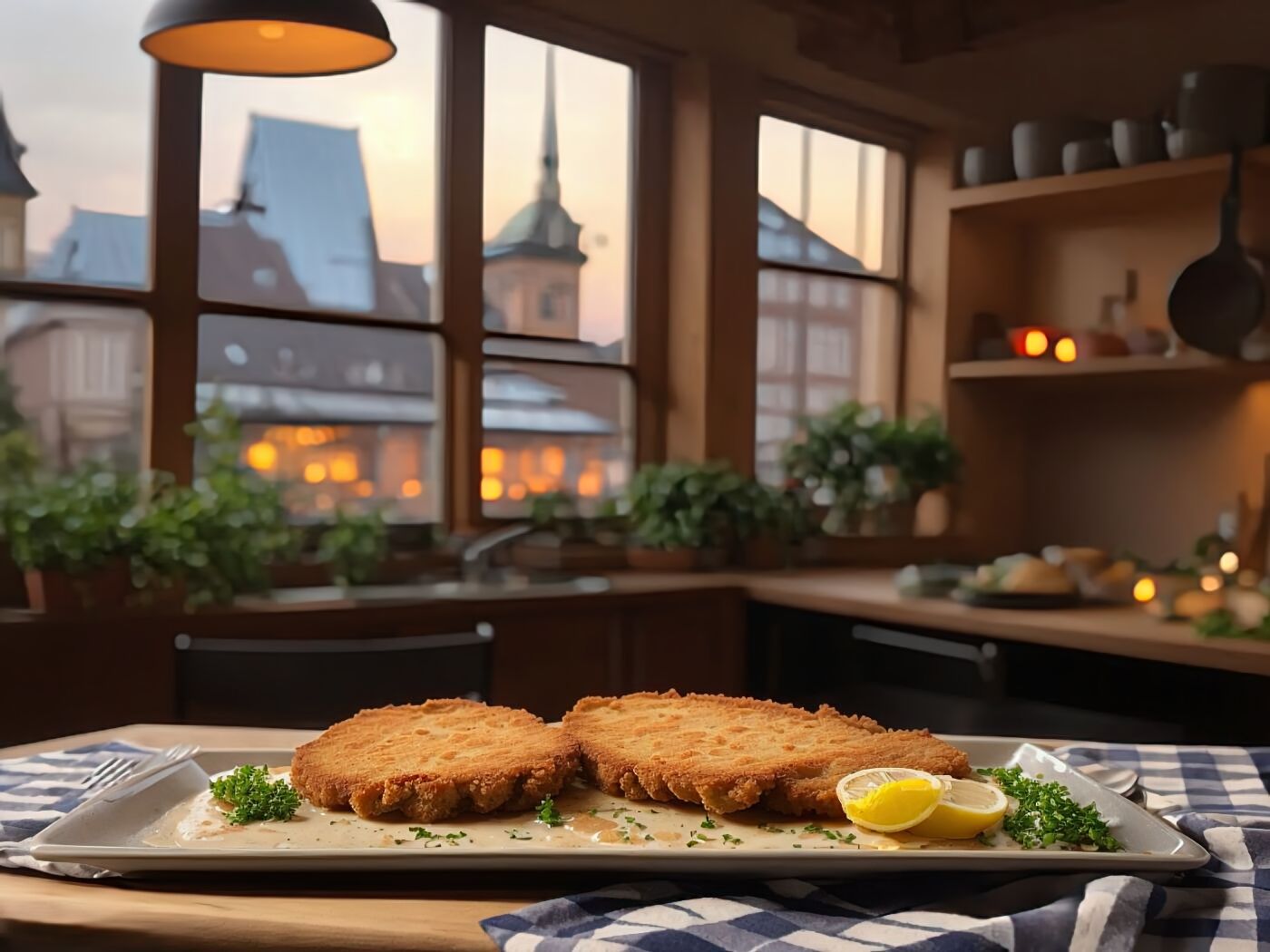
German Schweineschnitzel Recipe is a delicious and popular dish that originated in Germany. This dish is made with boneless pork steaks or chops, all-purpose flour, eggs, plain breadcrumbs or panko, and oil for frying. It can also be prepared using boneless pork or veal chops.
To make the German Schweineschnitzel, the boneless pork steaks or chops are first coated in a mixture of all-purpose flour and salt. Then, they are dipped in lightly beaten eggs and coated with plain breadcrumbs or panko. After that, the coated pork is fried in oil until it turns golden brown and crispy. It is important to use a neutral-tasting oil with a high smoke point for frying.
Want more ideas to round-out your Brazilian Recipes Box?
A lot of great options are in these posts!
25 Easy Authentic German Food Recipes
The German Schweineschnitzel is known for its delicious flavors and crispy texture. The combination of the tender meat and the crispy coating creates a satisfying contrast in every bite. This dish is often served with a squeeze of lemon juice and garnished with lemon slices, adding a refreshing tang to the flavors.
In terms of nutritional benefits, the German Schweineschnitzel can be a good source of protein from the pork. Protein is important for the growth and repair of our body tissues. However, it’s worth noting that this dish is fried, so it may have a higher fat content compared to other cooking methods. It’s recommended to enjoy it in moderation as part of a balanced diet.
You May Want to Join The World Recipes With Our Big Escape
Share your own recipes in our Facebook Group. Find recipes from all over the world. Learn more about International Cuisine and how you can surprise your family with new and exciting foods from all over the world.
For More Photos Visit Our Instagram at World Recipes Daily
German Schweineschnitzel Recipe is a versatile dish that can be enjoyed on its own or paired with various side dishes. It can be served with mashed potatoes, sauerkraut, or a fresh salad. The crispy and flavorful nature of this dish makes it a popular choice among food enthusiasts.
In conclusion, German Schweineschnitzel Recipe is a classic German dish made with boneless pork or veal, coated in flour, eggs, and breadcrumbs, then fried until golden and crispy. It offers delicious flavors, versatility in serving options, and can be enjoyed as part of a balanced diet.

How To Make Our German Schweineschnitzel Recipe
Ingredients (8 Servings)
8 boneless pork steaks or chops
2 cup all-purpose flour combined with 1 teaspoon salt
4 large eggs, lightly beaten
1.5 cup plain breadcrumbs or panko
Oil for frying (use a neutral-tasting oil with a high smoke point)
2 teaspoon salt
1 teaspoon black pepper
2 tablespoon lemon juice
lemon slices for garnish
Instructions
1. Preparing the Pork:
a. Place the boneless pork steaks or chops on a cutting board.
b. Use a meat mallet to tenderize the pork, pounding each piece until it is about 1/4-inch thick.
c. Sprinkle 2 teaspoons of salt and 1 teaspoon of black pepper evenly over the pork, rubbing it in gently.
d. Drizzle 2 tablespoons of lemon juice over the seasoned pork, allowing it to marinate for 10 minutes.
2. Coating the Pork:
a. In a shallow dish, combine 2 cups of all-purpose flour with 1 teaspoon of salt.
b. In another shallow dish, lightly beat 4 large eggs.
c. Place 1.5 cups of plain breadcrumbs or panko in a separate shallow dish.
d. Take one piece of seasoned pork and coat it in the flour mixture, shaking off any excess.
e. Dip the floured pork into the beaten eggs, ensuring it is fully coated.
f. Press the egg-coated pork into the breadcrumbs or panko, patting gently to adhere the crumbs to the surface.
g. Repeat the process for each piece of seasoned pork, placing the coated pieces on a plate.
3. Frying the Pork:
a. Heat a generous amount of oil in a large skillet over medium-high heat.
b. Carefully place a few pieces of coated pork into the hot oil, making sure not to overcrowd the skillet.
c. Cook the pork for about 3-4 minutes on each side, or until it turns golden brown and crispy.
d. Use tongs to transfer the cooked pork schnitzels to a paper towel-lined plate to drain excess oil.
e. Repeat the frying process with the remaining coated pork, adding more oil to the skillet if needed.
4. Serving the German Schweineschnitzel:
a. Arrange the cooked pork schnitzels on a serving platter.
b. Garnish with lemon slices for a fresh and tangy touch.
c. Serve the German Schweineschnitzel hot as a main dish.
d. Optionally, serve it with a side of mashed potatoes, sauerkraut, or a fresh salad to complement the flavors.
Estimated Prep Time: 20 minutes
Estimated Cooking Time: 25 minutes

Pots, Pan and Cooking Equipment Needed for the German Schweineschnitzel Recipe
Large skillet
Cutting board
Meat mallet
Shallow dish (for flour mixture)
Shallow dish (for beaten eggs)
Shallow dish (for breadcrumbs or panko)
Tongs
Serving platter
Paper towels (for draining)
Best Way to Store Leftovers From the the German Schweineschnitzel Recipe
a. Allow the German Schweineschnitzel to cool completely.
b. Place the leftovers in an airtight container.
c. Store the container in the refrigerator to keep the schnitzels fresh.
d. It is recommended to consume the leftovers within 2-3 days for best quality.
e. To reheat the leftovers, preheat the oven to 350°F (175°C), place the schnitzels on a baking sheet, and bake for about 10-15 minutes until warmed through.
Tips and Tricks For Easier Creation
Pound the pork evenly to ensure uniform thickness for consistent cooking.
Use a meat mallet or a rolling pin to tenderize the pork effectively.
Dip the pork into the breadcrumbs or panko, pressing firmly for better adherence.
Heat the oil to the correct temperature before frying to achieve a crispy coating.
Avoid overcrowding the skillet when frying to maintain the schnitzels’ crispiness.
Side Dishes and Desserts For the the German Schweineschnitzel Recipe
a. Mashed potatoes: Creamy and comforting, mashed potatoes complement the schnitzels well.
b. Sauerkraut: The tangy and flavorful sauerkraut adds a delicious contrast to the richness of the pork.
c. German potato salad: The tangy and warm potato salad brings a zesty element to the meal.
d. Red cabbage: Sweet and sour red cabbage pairs nicely with the schnitzels, adding color and texture.
e. Green salad: A fresh and crisp salad with a light vinaigrette dressing balances the richness of the schnitzels.
f. Roasted vegetables: A medley of roasted vegetables, such as carrots, broccoli, and Brussels sprouts, provides a nutritious and flavorful side.
g. Spaetzle: Traditional German egg noodles that can be served as a side dish or even topped with the schnitzels and gravy.
How To Serve the German Schweineschnitzel Recipe
a. Arrange the cooked pork schnitzels on a large serving platter.
b. Garnish with lemon slices for a touch of freshness.
c. Serve the schnitzels hot as the main dish, accompanied by the chosen side dishes.
d. Provide additional lemon wedges on the side for those who desire extra tanginess.
e. Encourage guests to squeeze fresh lemon juice over their schnitzels for enhanced flavor.
f. Consider serving the meal with a dollop of mustard or a creamy sauce for dipping.
g. Enjoy the German Schweineschnitzel while it’s still warm and crispy.
Dietary Substitution For the German Schweineschnitzel Recipe
1. Vegan Options for the German Schweineschnitzel Recipe:
a. Substitute boneless pork steaks or chops with firm tofu or tempeh slices.
b. Replace eggs with a mixture of ground flaxseeds and water as a binding agent.
c. Use almond or soy milk instead of eggs for coating the pork.
d. Opt for gluten-free breadcrumbs or crushed cornflakes as a vegan-friendly coating.
e. Choose a plant-based oil with a high smoke point, such as grapeseed or avocado oil, for frying.
f. Garnish with fresh herbs like parsley or cilantro for added flavor.
g. Serve the vegan schnitzels with a squeeze of lime instead of lemon for a citrusy touch.
2. Gluten-Free Options for the German Schweineschnitzel Recipe:
a. Use gluten-free all-purpose flour or a combination of rice flour and tapioca flour with salt as a coating mixture.
b. Verify that the breadcrumbs or panko you use are certified gluten-free.
c. Make sure the oil used for frying is gluten-free and not cross-contaminated.
d. Consider using a gluten-free breadcrumb alternative, such as crushed gluten-free crackers or potato chips.
e. Choose gluten-free boneless pork or veal chops.
f. Garnish with gluten-free lemon slices or omit the garnish if unsure about cross-contamination.
g. Serve with gluten-free side dishes like roasted potatoes or quinoa salad.
3. Vegetarian Options for the German Schweineschnitzel Recipe:
a. Replace boneless pork steaks or chops with sliced halloumi cheese or tofu.
b. Skip the eggs and use a non-dairy milk, such as almond or soy milk, for coating.
c. Use vegetarian-friendly breadcrumbs or panko.
d. Opt for a neutral-tasting oil suitable for frying.
e. Season the coating mixture with vegetarian-friendly seasonings like paprika or dried herbs.
f. Garnish with fresh herbs like basil or mint to enhance the flavors.
g. Serve with vegetarian side dishes like roasted vegetables or a green salad.
4. Mediterranean Diet Options for the German Schweineschnitzel Recipe:
a. Use extra-virgin olive oil for frying the schnitzels.
b. Season the coating mixture with Mediterranean herbs like oregano, thyme, or rosemary.
c. Serve the schnitzels with a side of Greek salad or roasted Mediterranean vegetables.
d. Garnish with lemon slices and fresh parsley.
e. Include whole grain side dishes like quinoa or couscous for added nutrition.
f. Accompany with a yogurt-based sauce or tzatziki for a Mediterranean twist.
g. Add a sprinkle of crumbled feta cheese on top for extra flavor.
5. Keto Diet Options for the German Schweineschnitzel Recipe:
a. Use almond flour or crushed pork rinds instead of all-purpose flour for the coating mixture.
b. Use a high-smoke-point oil such as avocado or coconut oil for frying.
c. Skip the breadcrumbs or panko and coat with grated Parmesan cheese or crushed pork rinds.
d. Choose boneless pork or veal chops for a keto-friendly option.
e. Season the coating mixture with keto-approved spices like garlic powder or dried herbs.
f. Serve with a side of cauliflower mash or zucchini noodles.
g. Garnish with lemon slices and fresh herbs for a burst of flavor.
6. Heart Healthy Diet Options for the German Schweineschnitzel Recipe:
a. Trim any visible fat from the boneless pork steaks or chops.
b. Use whole wheat flour or a mixture of whole wheat and all-purpose flour for the coating.
c. Opt for whole wheat breadcrumbs or panko.
d. Use a heart-healthy oil like canola or olive oil for frying.
e. Season the coating mixture with heart-healthy spices like turmeric or cayenne pepper.
f. Serve the schnitzels with a side of steamed vegetables or a mixed greens salad.
g. Garnish with lemon slices and fresh herbs for added freshness.
7. Paleo Options for the German Schweineschnitzel Recipe:
a. Replace the all-purpose flour with almond flour or coconut flour for the coating.
b. Use beaten eggs as a binder for the coating.
c. Use paleo-friendly breadcrumbs or panko made from crushed nuts or seeds.
d. Choose a paleo-approved oil, such as coconut oil or avocado oil, for frying.
e. Season the coating mixture with paleo-friendly herbs and spices like garlic powder or dried thyme.
f. Serve the schnitzels with a side of roasted sweet potatoes or sautéed kale.
g. Garnish with lemon slices and fresh herbs for a vibrant presentation.
8. Low Carb Options for the German Schweineschnitzel Recipe:
a. Use almond flour or coconut flour instead of all-purpose flour for the coating.
b. Use beaten eggs as a low-carb binder for the coating.
c. Use crushed pork rinds or almond meal as a low-carb substitute for breadcrumbs or panko.
d. Choose a neutral-tasting oil suitable for frying.
e. Season the coating mixture with low-carb herbs and spices like paprika or dried basil.
f. Serve the schnitzels with a side of steamed broccoli or cauliflower rice.
g. Garnish with lemon slices and fresh herbs for a burst of flavor.
9. Whole 30 Options for the German Schweineschnitzel Recipe:
a. Coat the pork with arrowroot powder instead of all-purpose flour for the coating.
b. Use beaten eggs for the coating.
c. Use almond flour or crushed nuts as a Whole30-approved substitute for breadcrumbs or panko.
d. Choose a Whole30-compliant oil, such as avocado oil or ghee, for frying.
e. Season the coating mixture with Whole30-approved spices like garlic powder or onion powder.
f. Serve the schnitzels with a side of roasted vegetables or a mixed greens salad.
g. Garnish with lemon slices and fresh herbs for added brightness.
10. Weight Watchers Options for the German Schweineschnitzel Recipe:
a. Trim any visible fat from the boneless pork steaks or chops.
b. Use whole wheat flour or a mixture of whole wheat and all-purpose flour for the coating.
c. Opt for whole wheat breadcrumbs or panko.
d. Use a cooking spray or a small amount of oil for a lighter frying method.
e. Season the coating mixture with herbs and spices for flavor without adding extra points.
f. Serve the schnitzels with a side of steamed vegetables or a light salad.
g. Garnish with lemon slices and fresh herbs for added freshness.
11. Low Fat Options for the German Schweineschnitzel Recipe:
a. Trim any visible fat from the boneless pork steaks or chops.
b. Use a minimal amount of flour for the coating, or opt for a thin coating of egg only.
c. Choose a low-fat breadcrumb alternative or use crushed cornflakes as a coating.
d. Use a non-stick skillet or a cooking spray to minimize the use of oil for frying.
e. Season the coating mixture with herbs and spices for flavor without adding additional fat.
f. Serve the schnitzels with steamed vegetables or a light salad.
g. Garnish with lemon slices and fresh herbs for a burst of flavor.
12. Vegetable Variations for the German Schweineschnitzel Recipe:
a. Substitute the boneless pork steaks or chops with slices of eggplant or zucchini.
b. Use a mixture of chickpea flour and salt for the coating.
c. Coat the vegetable slices with beaten eggs for binding.
d. Use a vegetable-based alternative for breadcrumbs or panko.
e. Choose a neutral-tasting oil suitable for frying.
f. Season the coating mixture with herbs and spices to enhance the flavors.
g. Serve the vegetable schnitzels with a side of roasted or grilled vegetables for a wholesome vegetarian option.
Please note that the given substitutions are general suggestions, and individual dietary needs and preferences may vary. It’s always recommended to check labels, choose quality ingredients, and consult with a healthcare professional or registered dietitian for personalized advice.

FAQ About the German Schweineschnitzel Recipe
What is a German Schweineschnitzel Recipe?
The German Schweineschnitzel Recipe is a classic German dish made with boneless pork steaks or chops. The pork is coated in a mixture of flour, eggs, and breadcrumbs, then fried until golden and crispy. It is known for its delicious flavors and crispy texture.
How do you make a German Schweineschnitzel Recipe?
To make the German Schweineschnitzel Recipe, you start by tenderizing the boneless pork steaks or chops and seasoning them with salt, pepper, and lemon juice. Then, you coat the pork in a mixture of flour, dip it in beaten eggs, and coat it with breadcrumbs. Finally, you fry the coated pork in oil until it becomes golden brown and crispy.
What are some side dishes that go well with a German Schweineschnitzel Recipe?
There are several side dishes that pair nicely with a German Schweineschnitzel Recipe. Some popular choices include mashed potatoes, sauerkraut, German potato salad, red cabbage, green salad, roasted vegetables, spaetzle (German egg noodles), and various sauces or gravies.
Can I make a vegetarian version of the German Schweineschnitzel Recipe?
Yes, you can make a vegetarian version of the German Schweineschnitzel Recipe by using plant-based alternatives. Instead of pork, you can use sliced halloumi cheese or tofu as the main ingredient. The coating can be made with vegetarian-friendly ingredients like flour, plant-based milk, and vegetarian breadcrumbs. The cooking method remains the same.
Are there any health benefits to eating a German Schweineschnitzel Recipe?
The German Schweineschnitzel Recipe can provide a good source of protein from the pork or vegetarian alternatives used. Protein is important for the growth and repair of body tissues. However, it’s worth noting that the dish is fried, so it may have a higher fat content. To make it healthier, consider using lean cuts of meat, opting for whole wheat flour or alternative coatings, and using healthier cooking methods such as baking or grilling. Additionally, incorporating side dishes with vegetables or salads can increase the nutritional value of the meal.
Final Thoughts
The German Schweineschnitzel Recipe is a delicious and versatile dish that offers a delightful combination of flavors and textures. The crispy and golden-brown coating, achieved by coating boneless pork steaks or chops in flour, eggs, and breadcrumbs, provides a satisfying crunch with every bite. The tender and juicy pork, seasoned with salt, pepper, and a touch of lemon juice, adds a savory and tangy element to the dish.
One of the great advantages of the German Schweineschnitzel Recipe is its versatility. It can be served as a standalone main dish or paired with various side dishes to create a well-rounded meal. Mashed potatoes, sauerkraut, and German potato salad are popular accompaniments that complement the flavors of the schnitzel. The dish can be customized to suit different dietary preferences by making substitutions, such as using tofu or halloumi cheese for a vegetarian version.
From a nutritional standpoint, the German Schweineschnitzel Recipe provides a good source of protein from the pork. Protein is essential for the growth and repair of our body tissues. However, it’s important to note that the dish is fried, which means it may have a higher fat content compared to other cooking methods. To make it healthier, lean cuts of meat can be used, and alternative coatings like almond flour or crushed nuts can be considered.
In conclusion, the German Schweineschnitzel Recipe is a delightful dish that offers a satisfying combination of flavors and textures. Its versatility allows for various serving options and the ability to cater to different dietary preferences. While it provides a good source of protein, it’s important to enjoy it in moderation as part of a balanced diet. So why not give this recipe a try and experience the deliciousness of a traditional German dish in the comfort of your own kitchen?
German Schweineschnitzel Recipe
Ingredients
Equipment
Method
- a. Place the boneless pork steaks or chops on a cutting board.
- b. Use a meat mallet to tenderize the pork, pounding each piece until it is about 1/4-inch thick.
- c. Sprinkle 2 teaspoons of salt and 1 teaspoon of black pepper evenly over the pork, rubbing it in gently.
- d. Drizzle 2 tablespoons of lemon juice over the seasoned pork, allowing it to marinate for 10 minutes.
- a. In a shallow dish, combine 2 cups of all-purpose flour with 1 teaspoon of salt.
- b. In another shallow dish, lightly beat 4 large eggs.
- c. Place 1.5 cups of plain breadcrumbs or panko in a separate shallow dish.
- d. Take one piece of seasoned pork and coat it in the flour mixture, shaking off any excess.
- e. Dip the floured pork into the beaten eggs, ensuring it is fully coated.
- f. Press the egg-coated pork into the breadcrumbs or panko, patting gently to adhere the crumbs to the surface.
- g. Repeat the process for each piece of seasoned pork, placing the coated pieces on a plate.
- a. Heat a generous amount of oil in a large skillet over medium-high heat.
- b. Carefully place a few pieces of coated pork into the hot oil, making sure not to overcrowd the skillet.
- c. Cook the pork for about 3-4 minutes on each side, or until it turns golden brown and crispy.
- d. Use tongs to transfer the cooked pork schnitzels to a paper towel-lined plate to drain excess oil.
- e. Repeat the frying process with the remaining coated pork, adding more oil to the skillet if needed.
- a. Arrange the cooked pork schnitzels on a serving platter.
- b. Garnish with lemon slices for a fresh and tangy touch.
- c. Serve the German Schweineschnitzel hot as a main dish.
- d. Optionally, serve it with a side of mashed potatoes, sauerkraut, or a fresh salad to complement the flavors.

